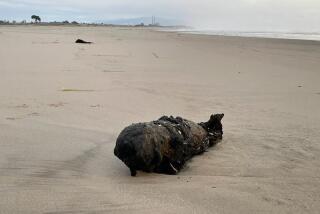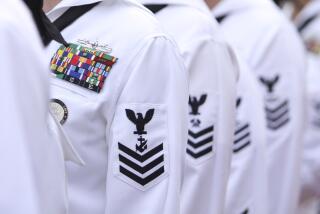At Navy School, Students Acquire Disarming Skills
- Share via
INDIAN HEAD, Md. — Among the thousands of security personnel providing protection for the Democratic National Convention in Chicago is a contingent of 175 Navy-trained bomb experts who learned their trade here on the banks of the Potomac River.
And demand for the special school’s graduates is soaring.
“The terrorist threat in the U.S. looks to be on the rise,” says Staff Sgt. Brian Brady, an instructor in homemade bombs. “For us, that means business is booming. Excuse the pun.”
Inside the Navy’s Explosive Ordnance Disposal School, the display cases are not filled with athletic trophies and academic memorabilia. Instead, they contain detonators, grenades and land mines. In the classrooms, teachers drill students about different kinds of pipe bombs, antiaircraft missiles, nuclear weapons and just about anything that can explode.
“What is this?” asks Chief William “Buck” Dyer, an instructor in land mines, grenades and other ground ordnance.
Dyer answers for the class: “It’s an RPG-7.” That stands for rocket-propelled grenade, model No. 7--a Russian antitank weapon with a nubby green cone attached to a slim white cylinder containing knife-like fins that spring out after being fired.
“Is it armed?”
“Yes, sir,” a student answers.
“Negative,” Dyer says. “It is not armed. How do we proceed once we know this?”
By test day, students must correctly identify each weapon, how it works, where it was made, how much power it can deliver and what tools and procedures are necessary to disarm it. This is a field with little margin for error; failing the test can mean dismissal from the school.
Those who pass begin to work directly with the more than 8,000 inert-explosive devices maintained by the school. The devices cannot explode, but many are wired to blocks of TNT a safe distance away that detonate at the tiniest disarming mistake, thus providing a loud reminder of what might happen if this were not just practice.
Chief Brian Hodge, a ground-ordnance instructor, shows students how to find tripwires, land mines, grenades and rockets.
Dressed in fatigues, Hodge stands above a student who is on his knees, face close to the ground, gingerly probing the dirt with a thin metal rod. “You have to be suspicious all the time,” Hodge says, telling the student to make sure he has found everything buried in the ground, reminding him there might be a booby-trap.
To Airman 1st Class Angelia F. Bryan, 19, a student from the Air Force, “the challenge is in conquering something that could destroy you.”
During its 50 years, the school has trained more than 27,000 military personnel, 162 of whom later died while disarming bombs. Most of the fatalities occurred while they were disarming devices left over from World War II. Only eight have died in the last 10 years.
During the 1991 Persian Gulf War and in years since, 150 graduates have worked to dismantle or detonate land and sea mines. About 100 are on such duty in Bosnia.
For some, like Bryan, the adventure and the prestige that go along with the title “bomb disposal technician” are what lures them to volunteer for the school.
Jeff Church, 22, plans to retire from the Army at 37, then begin working for a private firm. He says he expects to earn up to $100,000 a year for the dangerous work.
Private companies have contracted with countries such as Kuwait that need to rid themselves of land mines left behind by war.
Army Specialist Fred Kotowitz, 21, knows he will be assigned to Ft. Dix, N.J., and will travel with the U.S. Secret Service.
Forty Navy divers have been working with FBI officials in the waters off Long Island, N.Y., searching for evidence that a bomb brought down TWA Flight 800. Military teams also helped investigate the 1993 bombing of the World Trade Center and the 1995 bombing of the Alfred P. Murrah Federal Building in Oklahoma City.
More to Read
Sign up for Essential California
The most important California stories and recommendations in your inbox every morning.
You may occasionally receive promotional content from the Los Angeles Times.










